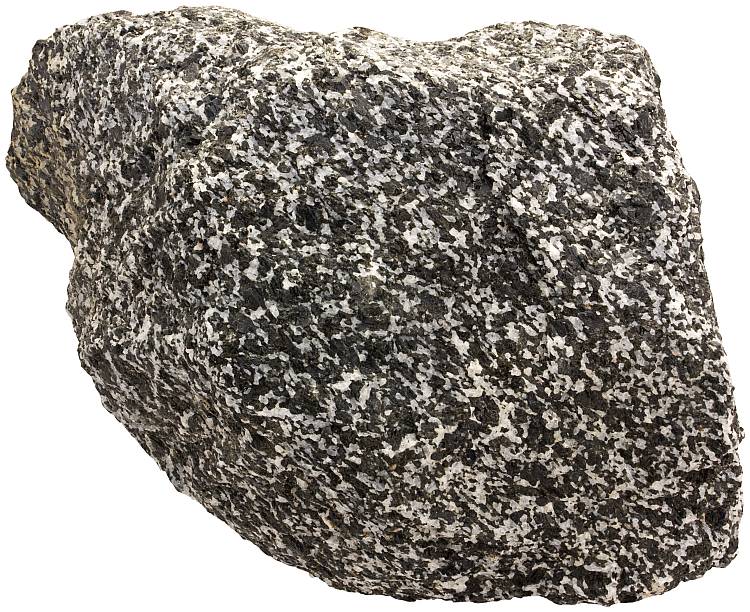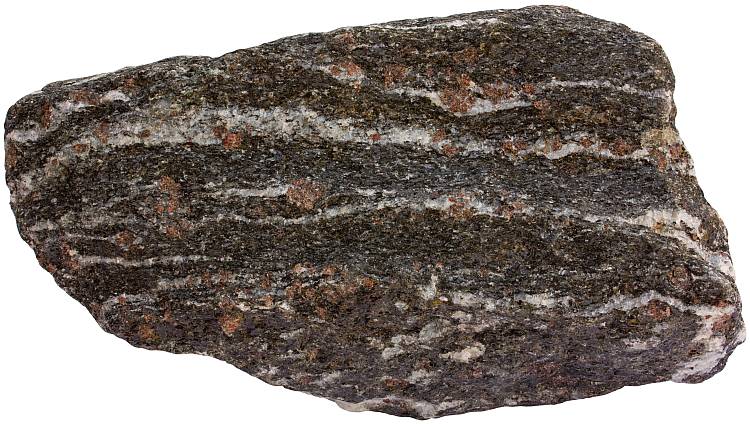Amphibolite is a common metamorphic rock. It is made of amphiboles (usually hornblende) and plagioclase. Most samples have a relatively simple composition: hornblende + plagioclase. Garnet (almandine), pyroxene, biotite, titanite, magnetite, epidote, chlorite, and quartz are also frequent constituents.

Main minerals in amphibolite are plagioclase (white) and hornblende. Senja, Norway. Width of sample 9 cm.
Amphibolite is a common rock of the metamorphic facies with the same name. However, not all amphibolites were formed within the pressure-temperature limits of the amphibolite facies and by no means are all rocks of this metamorphic facies amphibolites. So one should be careful when comparing amphibolitic rocks with the metamorphic facies that carries the same name. The temperature range of formation is usually 400…500 °C1. Amphibolites are usually either black or dark green, depending on the color of the dominant amphibole. These rocks are usually coarse-grained enough for the individual mineral grains to be seen with the unaided eye.
http://picasaweb.google.com/107509377372007544953/2015#6196127317767358722
Garnet is a common mineral in amphibolites. The sample above contains small reddish garnet crystals. Senja, Norway. Width of sample 11 cm.
http://picasaweb.google.com/107509377372007544953/2015#6196127308718613442
A contact between amphibolite (on the right) and tonalite pegmatite. Dark mineral in the lower left is biotite. Other minerals in tonalite are plagioclase and quartz. Senja, Norway. Width of sample 10 cm.
Amphibolite is a metamorphosed mafic igneous rock (basalt, gabbro) although it is usually difficult to determine the protolith because original features are often obliterated. Basalt is composed of pyroxene + plagioclase. In order to make amphibolite out of basalt, we need heat and pressure to initiate chemical reactions and also need to add water because amphiboles, unlike pyroxenes, are hydrous minerals. According to some sources, impure carbonate rocks (rich in clay content) may also metamorphose to amphibolitic rock. Prexifes para- and ortho- were used in the past to denote sedimentary and igneous protoliths, respectively. However, the term “para-amphibolite” is outdated and generally not used anymore. It is hard to think of an impurity in carbonate rocks where you can end up with amphibole and plagioclase irrespective of the type of metamorphism.
Amphibolite either lacks or has weakly developed foliation. Schistose rocks with a similar composition are hornblende schists. High grade dark-colored hornblende-bearing rock is hornblende gneiss.
It is a common rock type in mountain ranges and shield areas. It is a very common product of regional metamorphism which is associated with mountain building episodes (such rocks are often lineated or foliated because mountain building is a dynamic event that involves motion). Granitic intrusions (batholiths) are often surrounded by amphibolitic metamorphic rocks. Amphibolites are often associated with other metamorphic rocks like quartzite, schist, marble, gneiss. These rocks represent different protoliths that were metamorphosed during the same mountain building episode. Stripes of metamorphic rocks like these are often next to one another in geological maps.
The term “amphibolite” was invented by a French geologist Alexandre Brongniart, but he used it in a different manner. For Brongniart, every rock where amphiboles formed majority was amphibolite. That includes also melanocratic variety of igneous rock diorite and ultramafic rock hornblendite. Modern usage dates from a German geologist Harry Rosenbusch.
Amphibolite rarely hosts economic minerals, but the rock type is widely used as a construction material in road building (aggregate) and as a railroad ballast.
http://picasaweb.google.com/107509377372007544953/2015#6190952677684298834
A sample from Arendal, Norway. Width of sample 9 cm.

Foliated garnet amphibolite. Hullvann, Norway. Width of sample 16 cm.
http://picasaweb.google.com/107509377372007544953/2015#6190952758380395938
Amphibolite is shiny because hornblende has a strong luster. Arendal, Norway. Width of sample 10 cm.
References
1. De Vore, George (2003). Amphibolite. In: Encyclopedia of Sediments & Sedimentary Rocks (Ed. Middleton, V.). Springer. 593-594.
excellent , I realy enjoy from this site ,it is realy usefull for me thanks much
This is extremely helpful, especially because i am a high school student studying this particular rock. It was very difficult to find the right website with the information that i needed. This is ‘most’ of the information that i wanted although not all, i feel like even though you can find it on other pages you could’ve included a picture (or diagram) of rock cycle showing how and where this rock is formed? (; thankyou anyway
Pretty helpful yet not all infirmations are given nor further explaination which is needed by high school students like us ! But yet Thanks alOt ,it is worthy 🙂
It is really worthy ! Keep up yoUr nice work ,hope for more explaination 🙂
Tell me what kind of information did you expected to see? It may be easy to add.
This helped me so much!